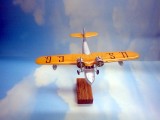Douglas RD-2 "DOLPHIN" USCG 1932
Back in the days of yore, modelers had but two recourses for getting the aircraft model of their choice: plastic kit or scratch built (usually wood construction). Then behold, VACUFORM burst upon the scene, kits of aircraft that no plastic manufacturer would offer. OK, they weren't really kits but somewhere in between a kit and a scratch built. I was swept up in the vacuform craze of the mid-1970's-early 1980's, ordering all sorts of planes from a number of US and UK companies. OK, they weren't really companies but fellow model devotees that worked out of their basement, attic, or garage.
The types offered were exciting; the actual product was not. For the un-initiated, the "kit" consisted of a thick sheet of white plastic with the "form" of the wings, cowlings, wheels, props struts, hull, etc stamped out on the sheet. (If you wanted panel lines be prepared to scribe like crazy). The "clear" parts were formed in a similar fashion but were actually foggy clear in appearence. Assembling this "kit" required knowledge, skill, glue, and some sharp xacto blades to cut the parts from the white sheet. And a lot of determination as most planes came with a set of assembly drawings done by a 10 year child. Need help with your build? No internet in those days to guide you along on your task, you were on your own brother.
I sure learned a lot and some of my attempts were pretty good. OK, most of them were awful and at that point in my life I went into wooden scratch built R/C boats-- a lot easier than vacuform planes!
I built the EXECUFORM Douglas RD-2 a few years back, it took a little bit of "twinking" to make it presentable. It's dated technology lags behind the latest craze; RESIN kits manufactured in model devotees basements, attics and garages.. I won't go into all the "Fun" I had building this gem suffice to say keep away from vacuform models unless you really enjoy this sort of thing, like a visit to the dentist...Oh, the U. S. Coast Guard flew 13 of these amphibs, from the 1930's up to WWII when they were traded in for newer patrol craft. Each plane possed both a serial number and a NAME! They were identified as stars or constellations, monikers like "ADHARA", CANOPUS", "VEGA", "SIRIUS" etc, painted on the planes nose. Ah, the golden age of flight, the golden age of vacuform...














BEEEEEEEAUTIFUL !
Man! What a skillfully built plane. impressive.
Mike...You did a masterful job with very little to work with I'm sure. I have never completed a vacuum kit to date, though I do have a Skyshark in the works. Vacuum kits are done much better these days, but still more work than plastic kits. I imagine you feel you really have accomplished something if you can achieve results such as this project.
Mike, this is a beautiful model, you've really used all your modelling skills and knowledge to build this. I remember looking at some vacuform kits years ago (I was into railway modelling then), and kept well away from them.
Exceptional effort. I'm betting there still is not a "conventional kit" of this aircraft out there.
I do keep an unbuilt vacuform around here for the same reason I go to a model train show when think I'm spending too much money on my hobby, to show me they potential error of my ways.
Very nice! Bravo!
Mike,
This absolutely superb. You did an excellent job on this. I have built one vacuform and have a couple of others started. That is where they will remain, started. I have to repeat what Joe said, "Beeeeeutiful"
Beautiful work and an excellent result.
There are still some vacuforms that beat injection kits. The Falcon Spitfire FR XVIII I did (you can see it here) is still the best Griffon Spitfire fighter in 1/48, and if you use the Falcon Sea Fury as your model with the Trumpeter kit as "aftermarket parts," you will get a far better model that way.
This is way cool. Vell done.
sweet model
Beautiful example of a rarely built kit. Nice work!
Mike- You are killing me! Great craftsmanship and a BEAUTIFUL result!